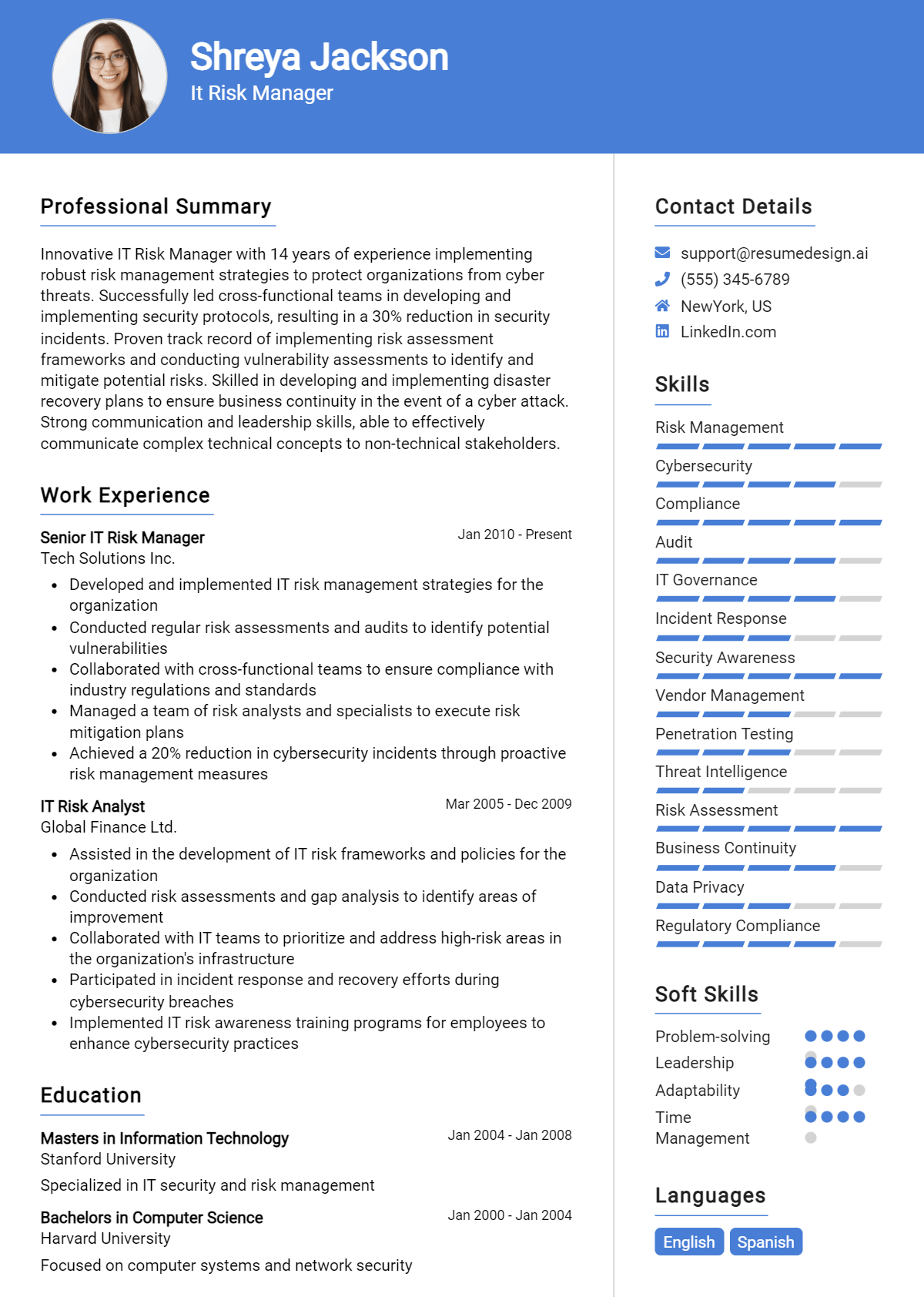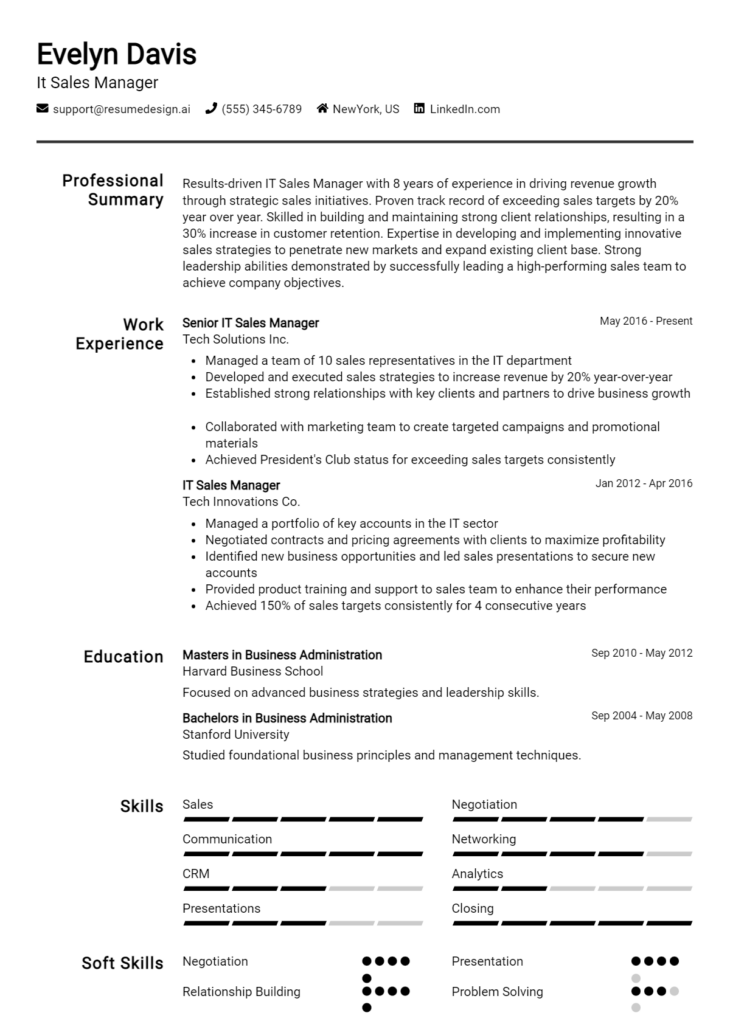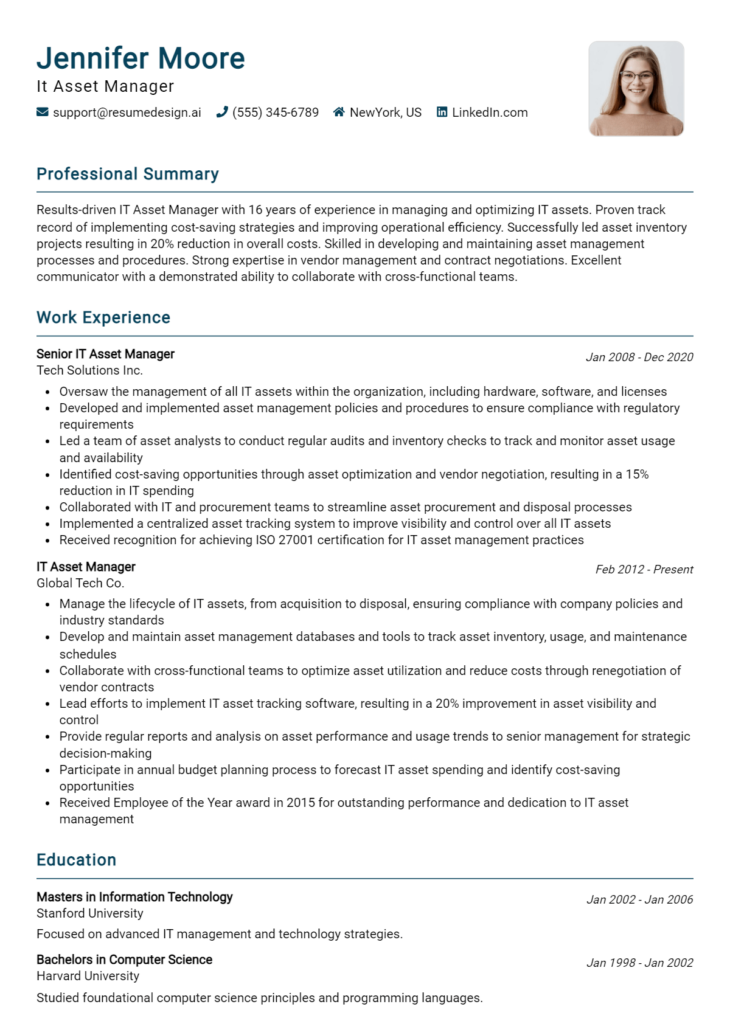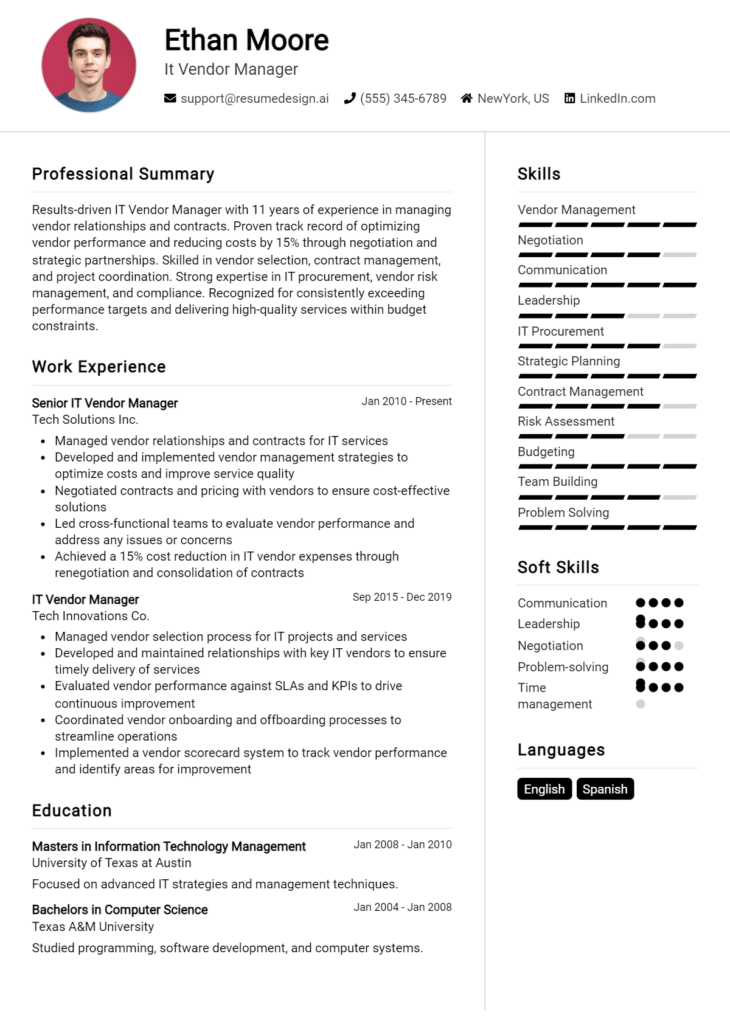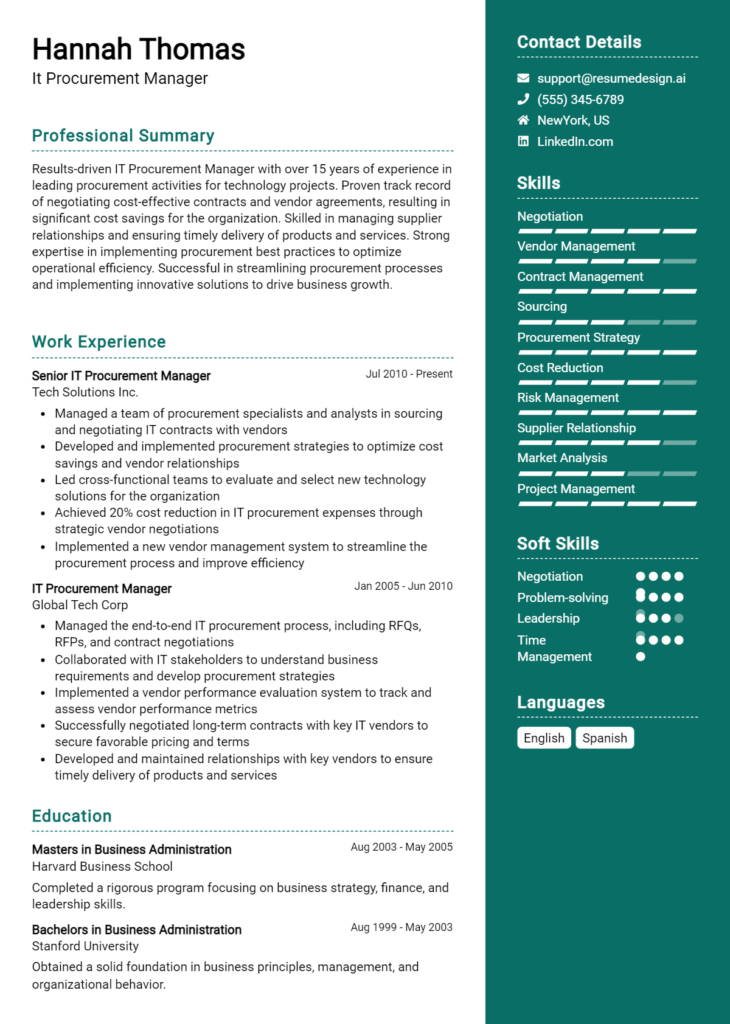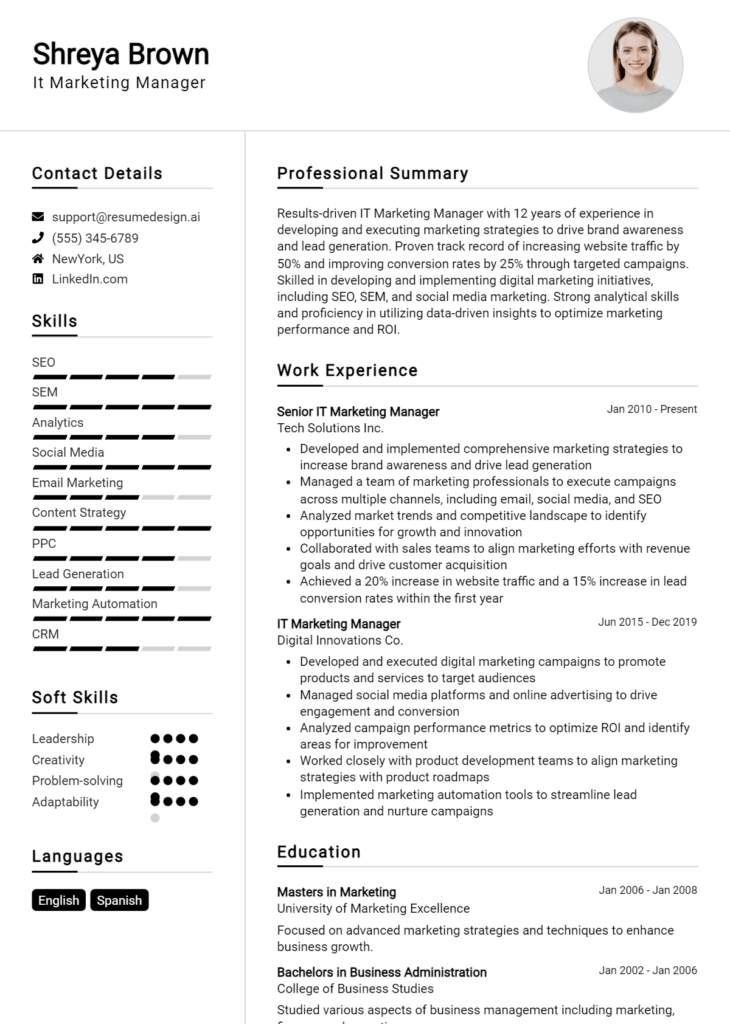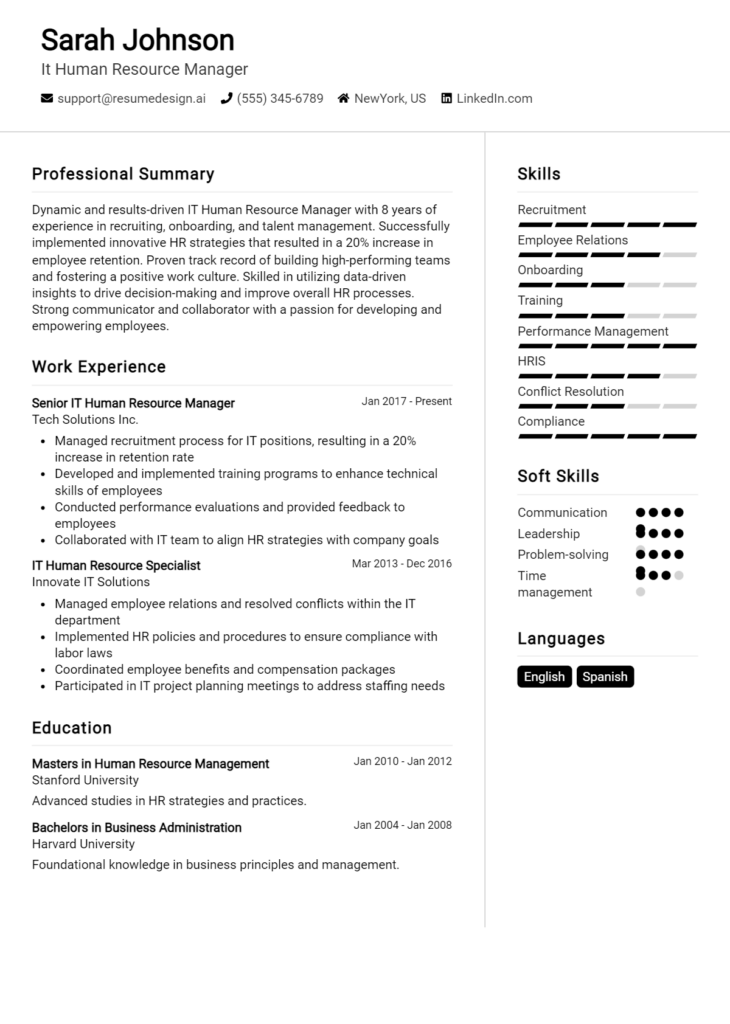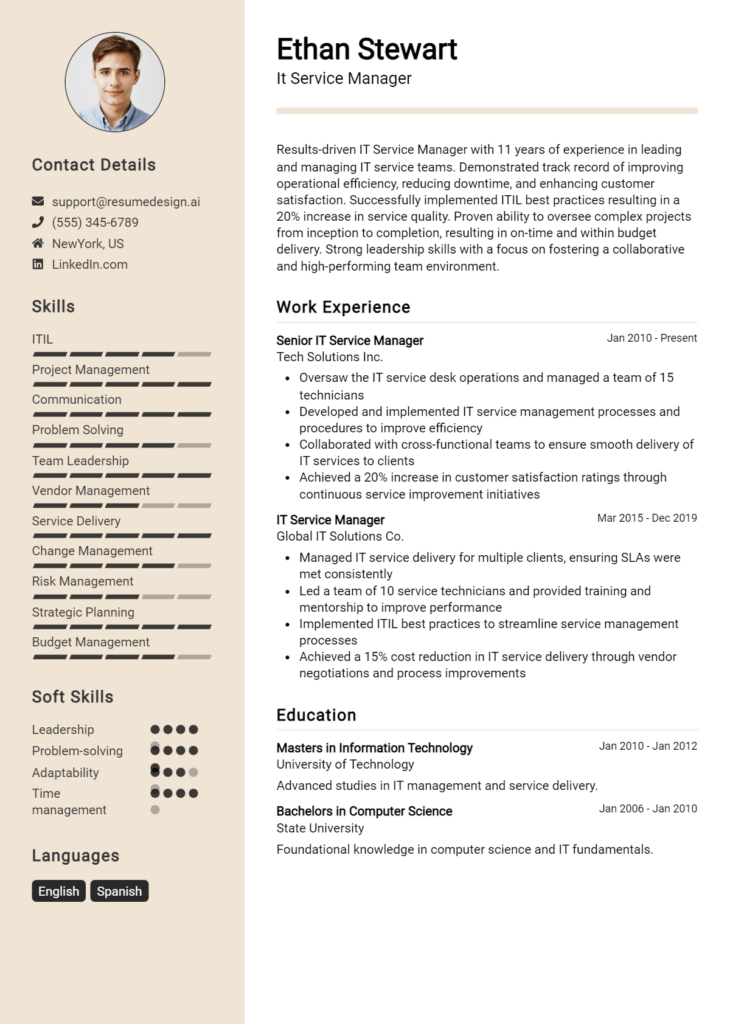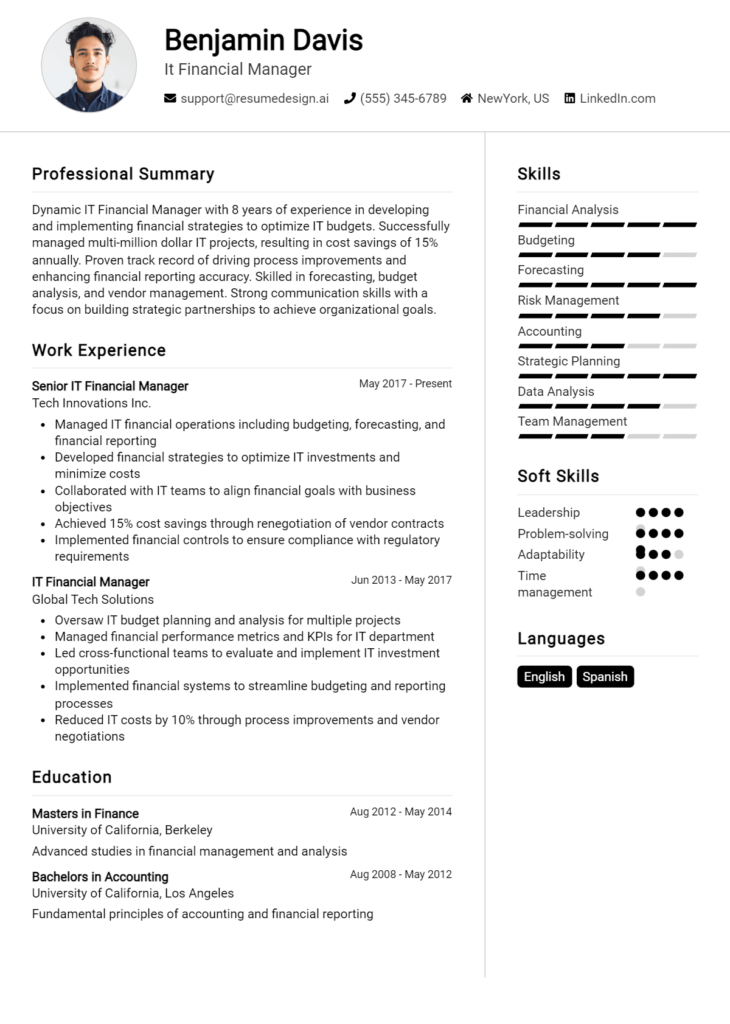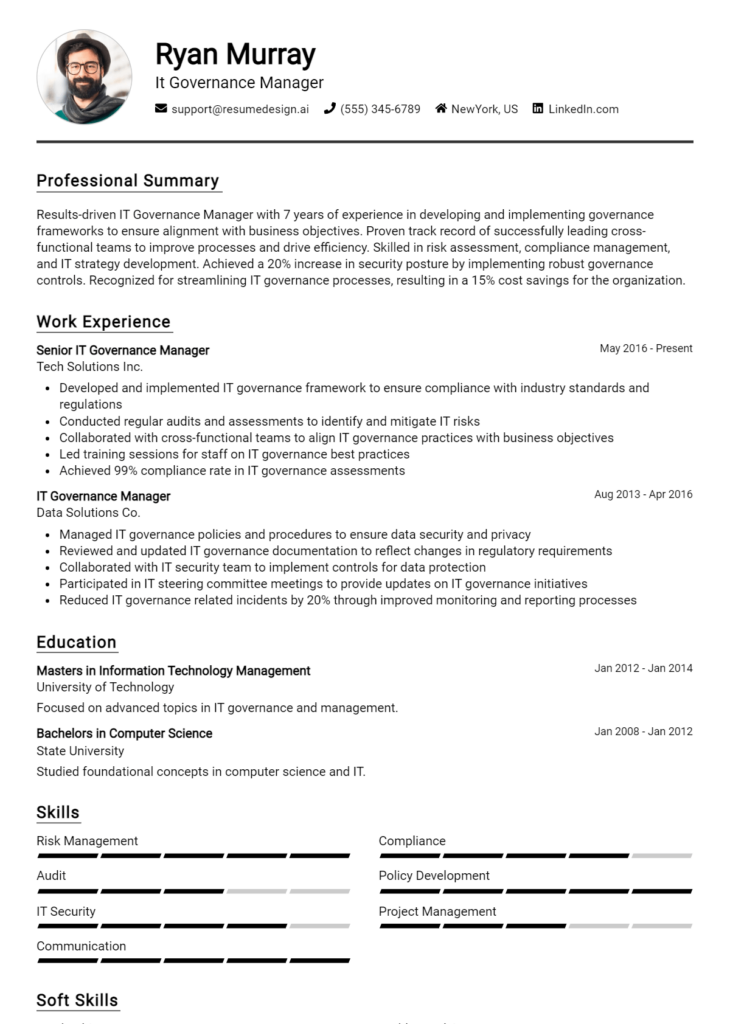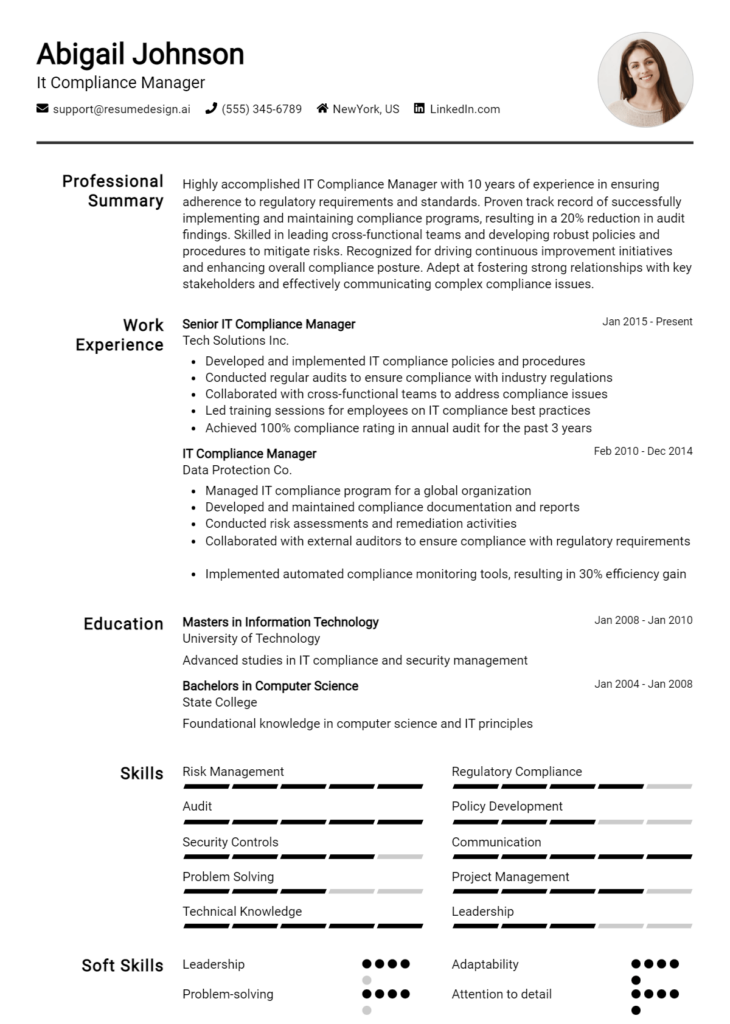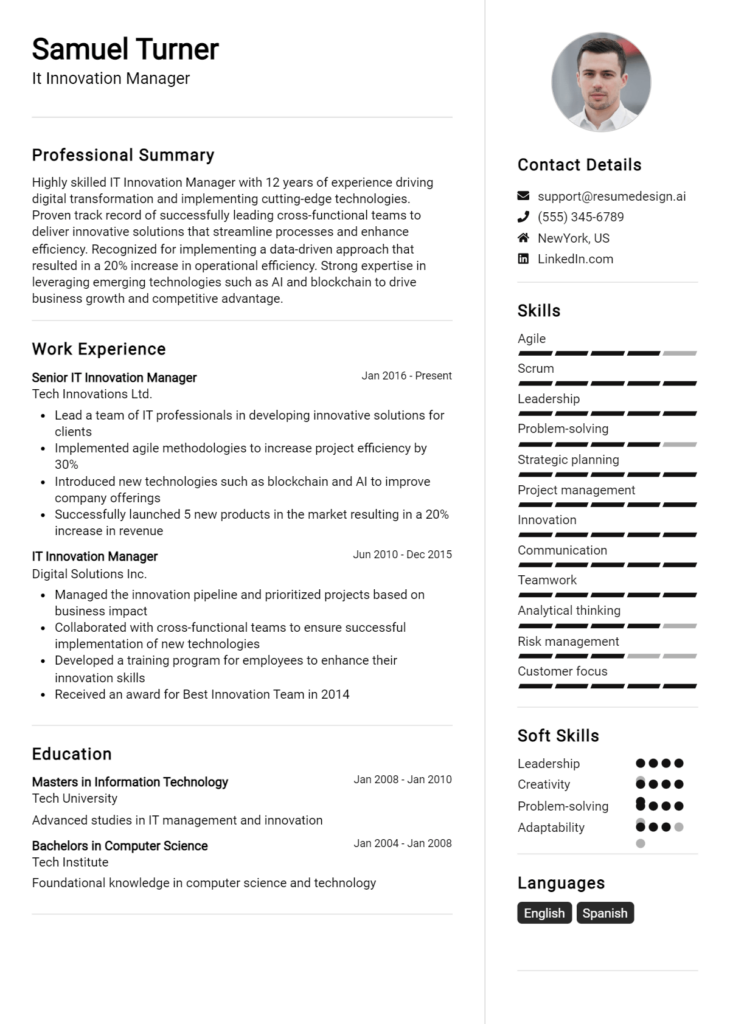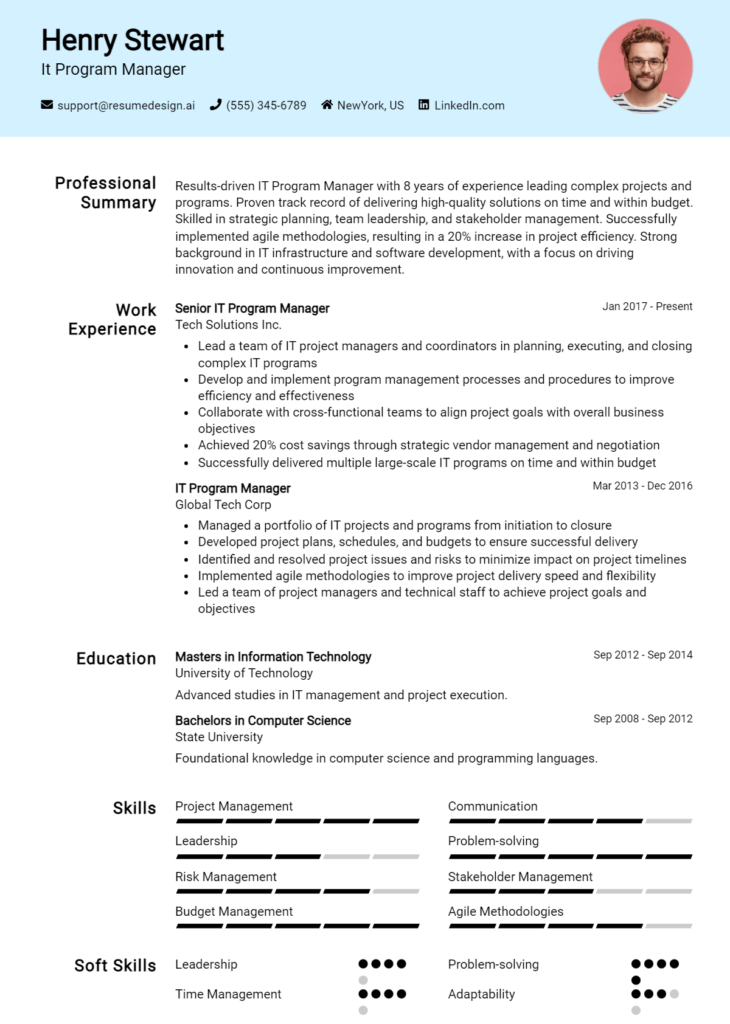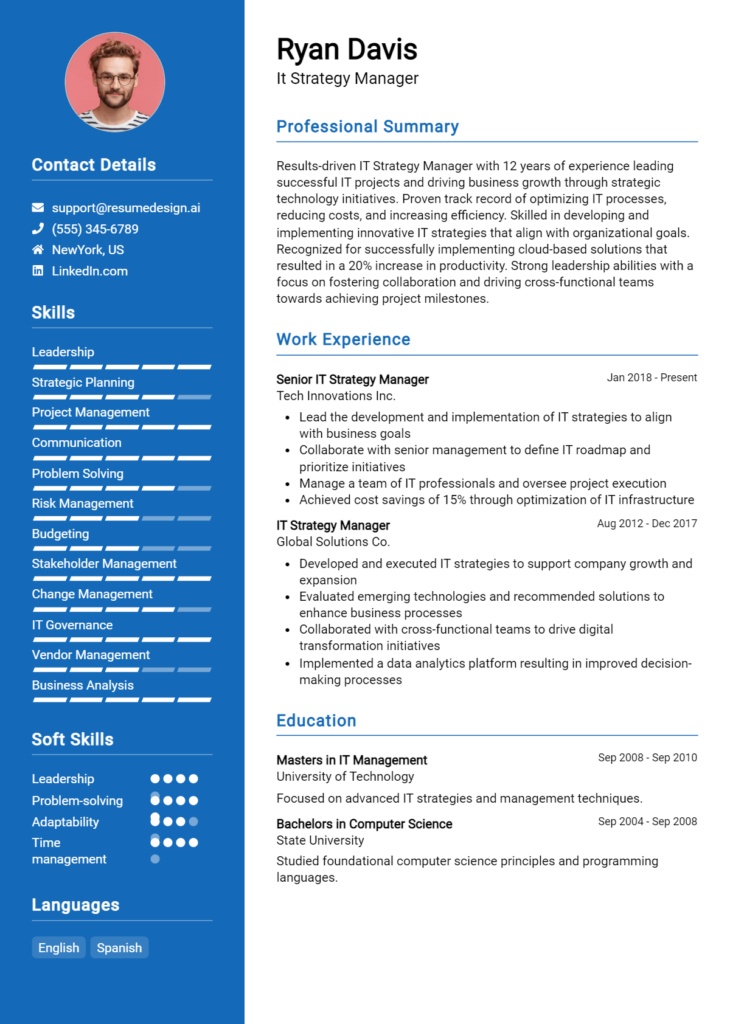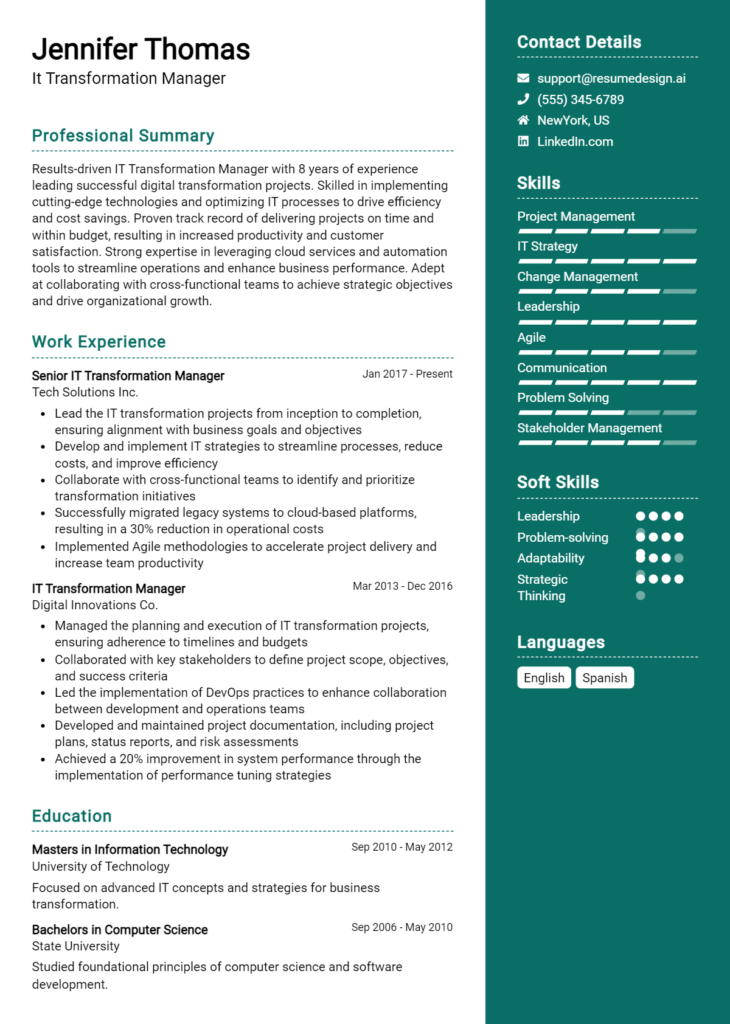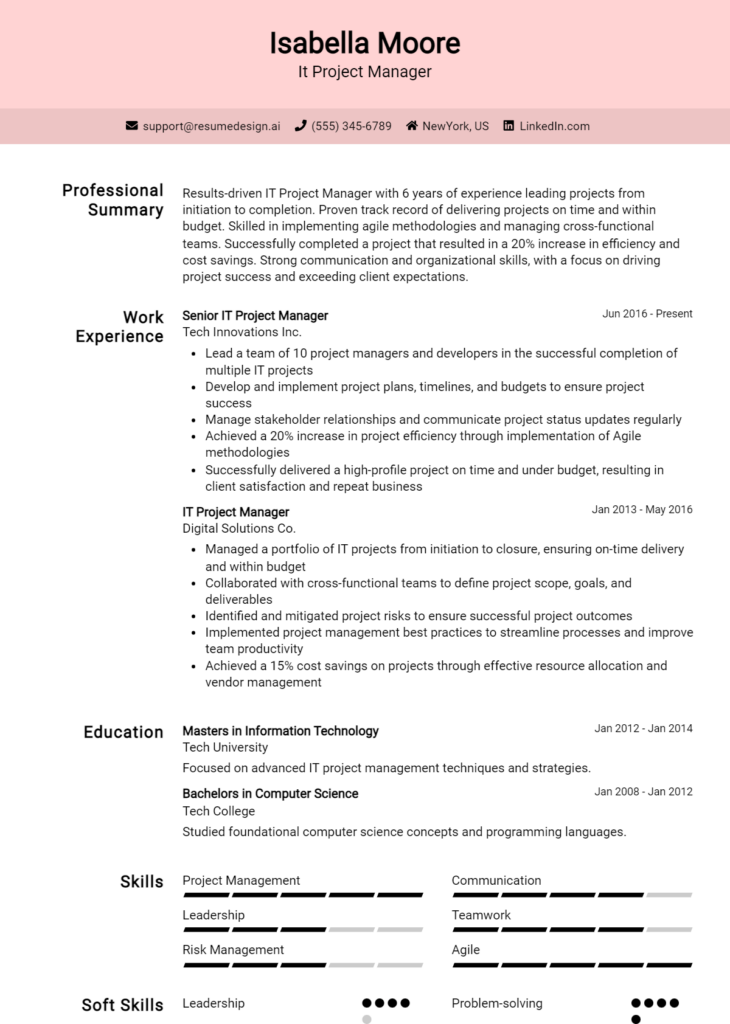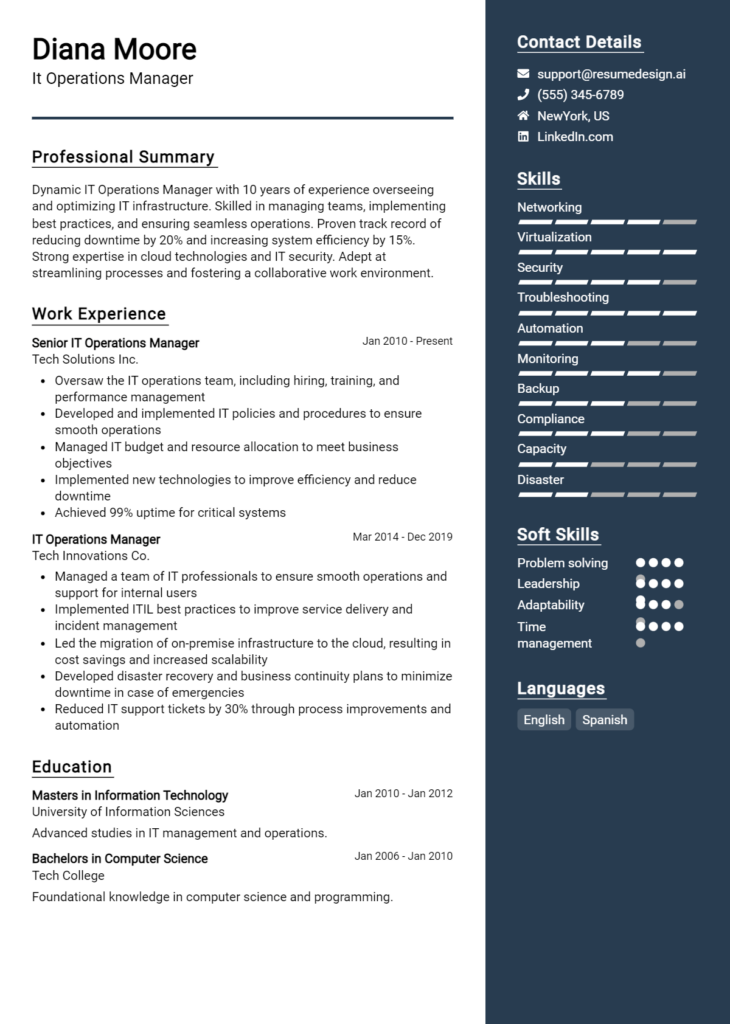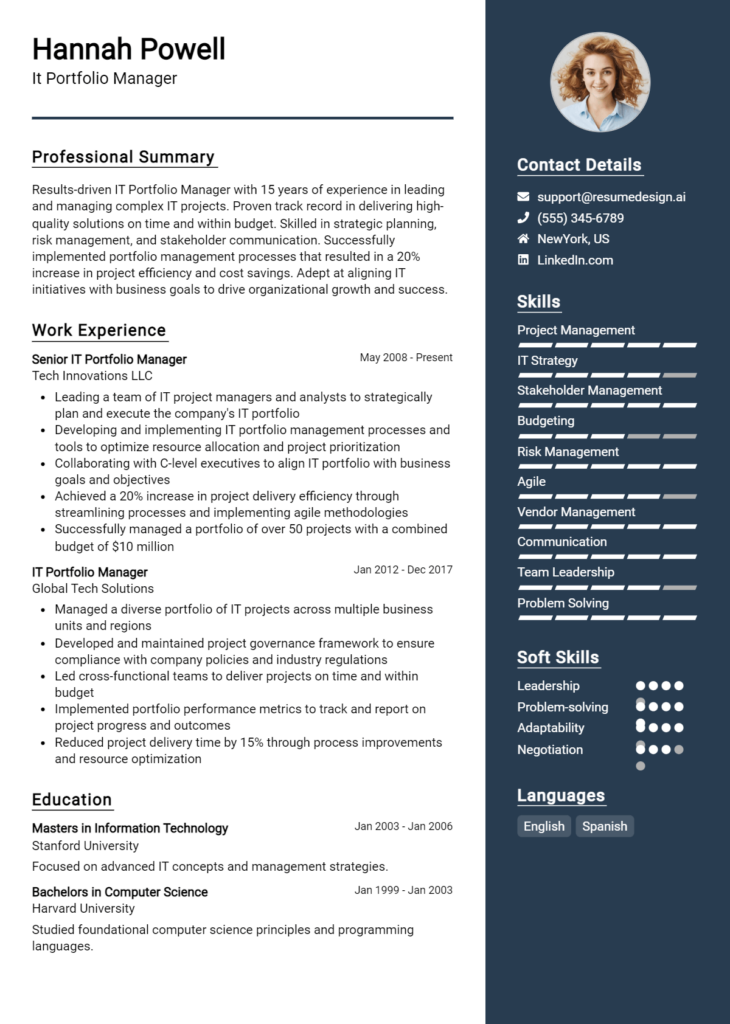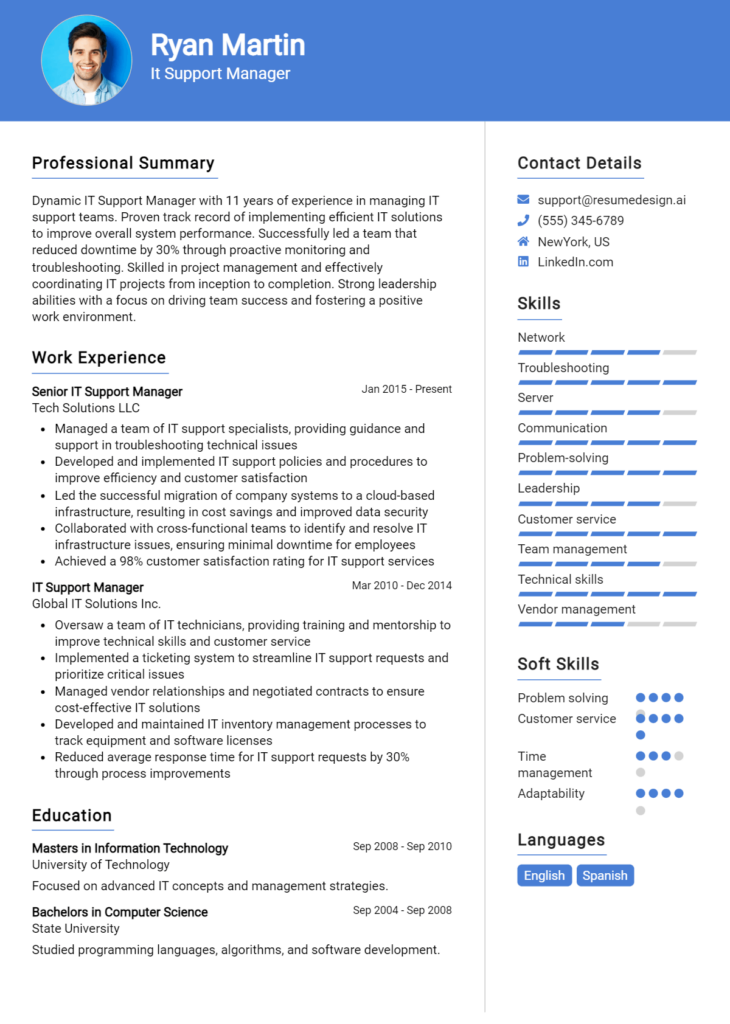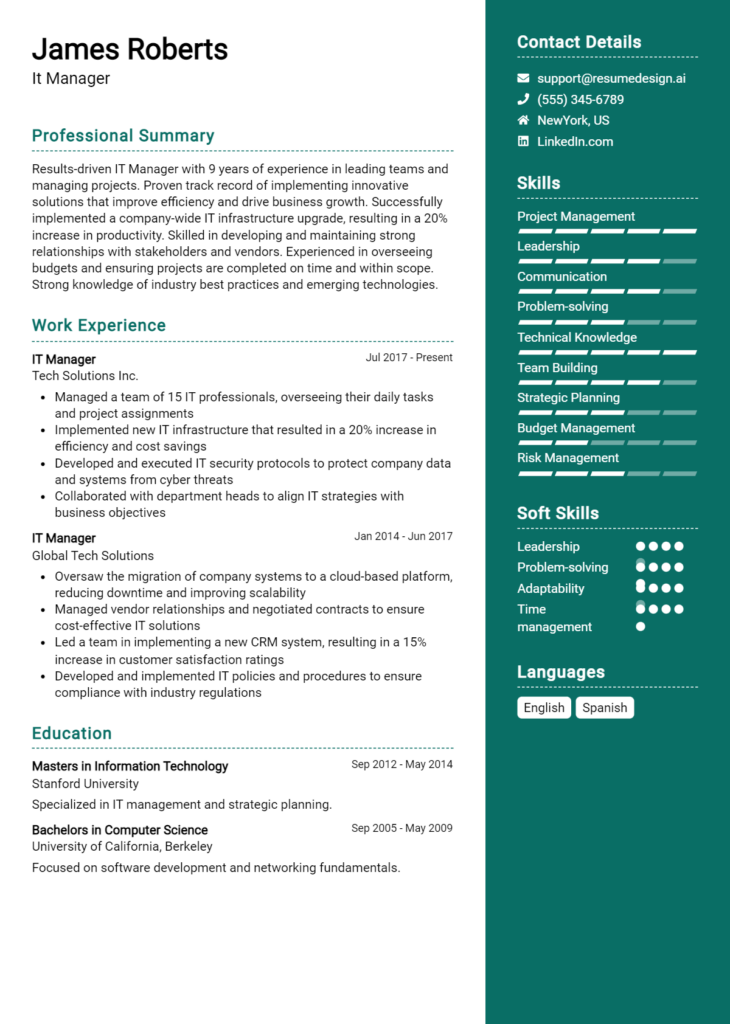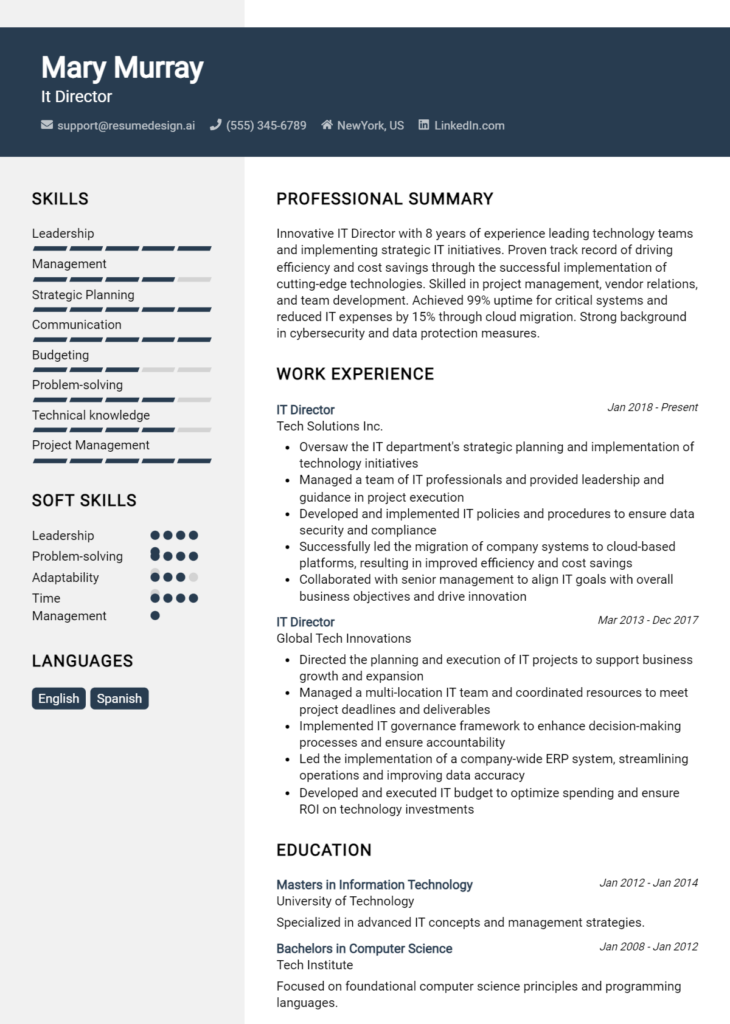IT Risk Manager Core Responsibilities
An IT Risk Manager plays a crucial role in safeguarding an organization's information technology assets by identifying, analyzing, and mitigating risks across various departments. This position requires a blend of technical expertise, operational insight, and strong problem-solving skills to bridge gaps between IT, compliance, and business functions. By effectively managing risks, the IT Risk Manager contributes to overall organizational goals, ensuring regulatory compliance and operational resilience. A well-structured resume that highlights these qualifications can significantly enhance career opportunities in this vital field.
Common Responsibilities Listed on IT Risk Manager Resume
- Conduct risk assessments to identify vulnerabilities and threats to IT systems.
- Develop and implement risk management frameworks and policies.
- Collaborate with cross-functional teams to ensure compliance with regulations.
- Monitor and report on risk exposure and mitigation strategies.
- Perform regular audits and assessments of IT controls.
- Provide training and guidance on risk management practices.
- Evaluate and recommend security technologies and solutions.
- Develop incident response plans and coordinate response efforts.
- Communicate risk findings to stakeholders at various levels.
- Stay updated on industry trends and regulatory changes.
- Facilitate risk management workshops and meetings.
High-Level Resume Tips for IT Risk Manager Professionals
In the competitive field of IT risk management, a well-crafted resume serves as your first opportunity to make a lasting impression on potential employers. It's not just a document detailing your work history; it's a powerful marketing tool that needs to effectively communicate your skills, accomplishments, and relevance to the specific role you are targeting. A strong resume can set you apart from other candidates by clearly showcasing your expertise in identifying, assessing, and mitigating IT risks. This guide will provide practical and actionable resume tips specifically tailored for IT Risk Manager professionals, helping you to present yourself as the ideal candidate in this essential field.
Top Resume Tips for IT Risk Manager Professionals
- Tailor your resume to the job description by closely matching your skills and experiences with the qualifications listed in the posting.
- Highlight relevant experience in IT risk management, including previous job titles, responsibilities, and the specific risks you've managed.
- Quantify your achievements where possible, using metrics to demonstrate your impact, such as reduced incidents or improved compliance rates.
- Include industry-specific skills, such as knowledge of regulatory frameworks (e.g., GDPR, HIPAA) and risk assessment methodologies.
- Showcase certifications that are relevant to IT risk management, such as CISSP, CRISC, or CISM, as they can enhance your credibility.
- Use action verbs to describe your responsibilities and achievements, which will make your resume more dynamic and engaging.
- Incorporate keywords from the job description to help your resume pass through Applicant Tracking Systems (ATS) and catch the attention of hiring managers.
- Maintain a clean, professional layout with clear headings and bullet points to ensure easy readability.
- Keep your resume concise; ideally, it should not exceed two pages, focusing on the most relevant and recent experiences.
- Include a summary statement at the top that succinctly outlines your expertise and career goals, making it clear why you are a great fit for the role.
By implementing these tips, you can significantly increase your chances of landing a job in the IT Risk Manager field. A polished and targeted resume will not only highlight your qualifications but also demonstrate your commitment to the profession, making you a compelling candidate for potential employers.
Why Resume Headlines & Titles are Important for IT Risk Manager
In the competitive field of IT risk management, a well-crafted resume can be the key to standing out among a sea of qualified candidates. Resume headlines and titles serve a crucial role, as they are often the first thing hiring managers notice. A strong headline or title can quickly grab attention and summarize a candidate's key qualifications in one impactful phrase. It should be concise, relevant, and directly aligned with the job being applied for, effectively setting the tone for the rest of the resume and making a compelling case for the candidate's fit for the role.
Best Practices for Crafting Resume Headlines for IT Risk Manager
- Keep it concise—aim for one impactful phrase.
- Make it role-specific—include terms relevant to IT risk management.
- Highlight key qualifications—focus on core skills and experiences.
- Use action words to convey proactivity and impact.
- Avoid jargon—ensure clarity for a broader audience.
- Customize for each application—tailor the headline to the specific job description.
- Showcase measurable achievements when possible.
- Prioritize readability—ensure the title stands out visually on the page.
Example Resume Headlines for IT Risk Manager
Strong Resume Headlines
Expert IT Risk Manager with 10+ Years in Cybersecurity and Compliance
Proven Track Record in IT Risk Assessment and Mitigation Strategies
Dynamic IT Risk Leader Specializing in Vulnerability Management
Strategic IT Risk Manager Focused on Enhancing Organizational Security Posture
Weak Resume Headlines
IT Professional Looking for Work
Experienced Manager in IT
The strong headlines are effective because they clearly convey the candidate’s key strengths, relevant experience, and specific areas of expertise within IT risk management. They utilize impactful language that reflects a proactive approach and measurable success, making them memorable to hiring managers. Conversely, the weak headlines fail to impress due to their vagueness and lack of specificity; they offer little insight into the candidate's qualifications or suitability for the role, making it easy for hiring managers to overlook them in favor of more compelling applicants.
Writing an Exceptional IT Risk Manager Resume Summary
A well-crafted resume summary is crucial for an IT Risk Manager as it serves as the first impression for hiring managers. This brief yet powerful introduction encapsulates a candidate's key skills, relevant experience, and notable accomplishments in the realm of IT risk management. A strong summary quickly captures attention and sets the tone for the rest of the resume, demonstrating how the candidate's background aligns with the specific demands of the role. It should be concise, impactful, and tailored to the job description, ensuring that the applicant stands out in a competitive job market.
Best Practices for Writing a IT Risk Manager Resume Summary
- Be concise: Aim for 3-5 sentences that summarize your qualifications effectively.
- Quantify achievements: Use numbers to illustrate your impact, such as reducing risks by a certain percentage.
- Focus on relevant skills: Highlight skills that are directly applicable to the IT risk management role.
- Tailor the summary: Customize your summary for each job application based on the specific job description.
- Use strong action verbs: Start sentences with dynamic verbs to convey your achievements and responsibilities.
- Highlight certifications: Mention any relevant certifications, such as CISSP or CRISC, that enhance your credibility.
- Showcase leadership: If applicable, emphasize any leadership roles or team contributions in risk management projects.
- Maintain a professional tone: Ensure that your language is formal and aligns with industry standards.
Example IT Risk Manager Resume Summaries
Strong Resume Summaries
Results-driven IT Risk Manager with over 8 years of experience in identifying and mitigating risks in information technology systems. Successfully reduced security incidents by 40% through the implementation of a comprehensive risk assessment framework.
Detail-oriented IT Risk Manager with a proven track record in compliance and regulatory frameworks, leading cross-functional teams to enhance data security protocols. Achieved a 30% improvement in audit scores over two years.
Strategic IT Risk Manager skilled in developing risk management strategies that align with business objectives. Instrumental in reducing operational risks by 25% through effective risk assessments and stakeholder engagement.
Weak Resume Summaries
Experienced IT professional looking to manage risks in a company. I have worked in various IT roles and understand the importance of risk management.
IT Risk Manager with a background in IT. I am interested in helping companies manage their IT risks and improve their systems.
The examples of strong resume summaries demonstrate clear, quantifiable achievements and specific skills relevant to the IT Risk Manager position, making them impactful and tailored to the role. In contrast, the weak summaries lack detail and specific outcomes, making them too generic and insufficient to capture the interest of hiring managers.
Work Experience Section for IT Risk Manager Resume
The work experience section of an IT Risk Manager resume is crucial as it serves as the primary showcase of a candidate's technical skills, leadership capabilities, and ability to deliver high-quality results in managing IT risks. This section not only highlights the candidate's familiarity with risk assessment frameworks and compliance standards but also provides insight into their proficiency in leading teams and executing strategic initiatives. To stand out, it is essential to quantify achievements and align experiences with industry standards, ensuring that potential employers can clearly see the impact of the candidate's contributions in previous roles.
Best Practices for IT Risk Manager Work Experience
- Highlight relevant technical skills such as risk assessment, compliance, and security frameworks.
- Quantify achievements with specific metrics (e.g., reduced risk incidents by X% or managed a budget of $Y).
- Showcase leadership by detailing team management and collaboration on projects.
- Align experiences with industry standards and best practices to demonstrate relevance.
- Focus on problem-solving capabilities and the implementation of risk mitigation strategies.
- Include certifications and training related to risk management and IT security.
- Use action verbs to convey a sense of proactivity and engagement in responsibilities.
- Tailor the work experience section to match the specific job description and requirements.
Example Work Experiences for IT Risk Manager
Strong Experiences
- Led a cross-functional team to implement a new risk management framework, resulting in a 30% reduction in compliance violations within the first year.
- Managed a $500,000 budget for IT security initiatives, successfully completing projects under budget and ahead of schedule.
- Developed and executed a comprehensive training program on IT risk management for over 200 employees, increasing awareness and reducing incident reports by 25%.
- Collaborated with external auditors to enhance risk assessment processes, achieving a 95% satisfaction rating on audit findings.
Weak Experiences
- Responsible for managing IT risks.
- Worked on various security projects.
- Assisted in compliance efforts.
- Participated in team meetings about risk management.
The examples listed above are considered strong because they provide specific, quantifiable outcomes that demonstrate the candidate's impact and technical leadership in IT risk management. Each strong experience includes measurable results and a clear narrative of collaboration and initiative. In contrast, the weak experiences lack detail and fail to convey the candidate's actual contributions or achievements, making them less compelling to potential employers.
Education and Certifications Section for IT Risk Manager Resume
The education and certifications section of an IT Risk Manager resume is crucial as it underscores the candidate's academic credentials and commitment to professional development in a rapidly evolving field. This section not only showcases the foundational knowledge gained through formal education but also highlights industry-relevant certifications and specialized training that demonstrate a candidate's expertise and dedication to continuous learning. By providing relevant coursework and recognized qualifications, candidates can enhance their credibility and illustrate their alignment with the demands of the IT Risk Manager role, making them more appealing to potential employers.
Best Practices for IT Risk Manager Education and Certifications
- Prioritize relevant degrees such as Computer Science, Information Security, or Risk Management.
- Include industry-recognized certifications like CISSP, CISM, or CRISC to showcase expertise.
- Highlight any specialized training programs or workshops that relate to IT risk management.
- List relevant coursework that demonstrates a solid understanding of risk assessment and mitigation strategies.
- Employ a clear and concise format to ensure readability and easy navigation for hiring managers.
- Keep the information up-to-date, removing any outdated degrees or certifications that no longer hold value in the industry.
- Consider including ongoing education efforts such as webinars or online courses that reflect a commitment to staying current.
- Tailor the section to align with the specific job requirements outlined in the job description.
Example Education and Certifications for IT Risk Manager
Strong Examples
- M.S. in Information Security Management, XYZ University, 2020
- CISSP (Certified Information Systems Security Professional), 2021
- CRISC (Certified in Risk and Information Systems Control), 2022
- Relevant Coursework: Risk Assessment, Cybersecurity Frameworks, and Compliance Management
Weak Examples
- B.A. in History, ABC College, 2015
- A+ Certification, 2010 (outdated for current IT risk management roles)
- Basic HTML Course, 2019 (not relevant to IT risk management)
- High School Diploma, 2010 (lacks specificity and relevance for the role)
The strong examples are considered effective because they directly align with the requirements and expectations of an IT Risk Manager role, showcasing relevant education and certifications that reflect a solid foundation in information security and risk management. In contrast, the weak examples indicate a lack of relevance or outdated qualifications that do not support the candidate's fit for the position, making them less compelling to potential employers.
Top Skills & Keywords for IT Risk Manager Resume
An effective IT Risk Manager resume relies heavily on showcasing the right skills, as these are crucial in demonstrating your ability to identify, analyze, and mitigate risks associated with information technology. The landscape of IT is ever-evolving, making it essential for professionals in this role to possess a blend of hard and soft skills that empower them to navigate challenges and implement robust risk management strategies. Highlighting these skills not only showcases your qualifications but also your commitment to maintaining the integrity and security of IT systems. For a comprehensive understanding of how to enhance your resume, explore the importance of skills and how to effectively present your work experience.
Top Hard & Soft Skills for IT Risk Manager
Soft Skills
- Strong communication abilities
- Analytical thinking
- Problem-solving skills
- Attention to detail
- Team collaboration
- Leadership capabilities
- Adaptability and flexibility
- Time management
- Critical thinking
- Stakeholder management
Hard Skills
- Risk assessment methodologies
- Knowledge of compliance frameworks (e.g., ISO 27001, NIST)
- Cybersecurity principles and practices
- IT governance frameworks (e.g., COBIT)
- Vulnerability assessment tools
- Incident response planning
- Data protection regulations (e.g., GDPR)
- Business continuity planning
- Threat modeling
- Proficiency in risk management software and tools
Stand Out with a Winning IT Risk Manager Cover Letter
I am writing to express my interest in the IT Risk Manager position at [Company Name], as advertised on [where you found the job listing]. With over [X years] of experience in IT risk management, cybersecurity, and compliance, I am confident in my ability to contribute to your organization's success by safeguarding its information assets and minimizing operational risks.
In my previous role at [Previous Company Name], I led a team responsible for conducting comprehensive risk assessments and developing strategies to mitigate risks associated with information technology. I successfully implemented a risk management framework that reduced vulnerabilities by [X%] within the first year. My proactive approach to identifying potential threats, coupled with my ability to communicate complex technical concepts to non-technical stakeholders, has allowed me to foster a culture of risk awareness across the organization.
I am particularly impressed by [Company Name]'s commitment to innovation and its focus on maintaining a robust cybersecurity posture. I am eager to leverage my expertise in risk analysis, regulatory compliance, and incident response to enhance your IT risk management strategy. My hands-on experience with regulatory frameworks such as ISO 27001, NIST, and GDPR will ensure that [Company Name] meets its compliance obligations while effectively managing risks in a rapidly evolving technological landscape.
Thank you for considering my application. I am excited about the opportunity to discuss how my background and skills align with the needs of your team. I look forward to the possibility of contributing to [Company Name] as your next IT Risk Manager and am available for an interview at your earliest convenience.
Common Mistakes to Avoid in a IT Risk Manager Resume
Crafting a compelling resume as an IT Risk Manager is crucial for standing out in a competitive job market. However, many candidates make common mistakes that can undermine their qualifications and experience. Avoiding these pitfalls can significantly enhance your chances of landing an interview. Below are some of the frequent errors to watch out for when creating your IT Risk Manager resume:
Vague Job Descriptions: Failing to provide specific details about your responsibilities can leave hiring managers unsure of your capabilities. Use quantifiable achievements to illustrate your impact in previous roles.
Ignoring Relevant Keywords: Many organizations use applicant tracking systems (ATS) to filter resumes. Neglecting to include industry-specific keywords can result in your resume being overlooked.
Lack of Tailoring: Sending the same generic resume for every application can diminish your chances. Tailor your resume to highlight skills and experiences that align with the specific job description.
Overloading with Technical Jargon: While it’s important to demonstrate your expertise, using too much technical jargon can alienate non-technical hiring managers. Strive for a balance that showcases your knowledge without overwhelming the reader.
Neglecting Soft Skills: IT Risk Managers must possess strong interpersonal skills. Failing to highlight your communication, leadership, and problem-solving abilities can give an incomplete picture of your fit for the role.
Inconsistent Formatting: A cluttered or inconsistent format can distract from your qualifications. Use a clean, professional layout with consistent fonts, bullet points, and headings to ensure readability.
Lack of Professional Development: Not mentioning certifications, training, or continuous education in risk management can make your resume appear stagnant. Highlight any relevant coursework or certifications to showcase your commitment to professional growth.
Omitting Metrics of Success: Not including quantifiable metrics can weaken your accomplishments. Use numbers and percentages to illustrate your contributions, such as risk reduction percentages or budget management figures, to make a stronger impact.
Conclusion
As we explored the pivotal role of an IT Risk Manager, it’s clear that this position is fundamental in safeguarding an organization’s information assets. Key responsibilities include identifying, assessing, and mitigating risks associated with technology and information systems. IT Risk Managers must possess a blend of technical expertise, analytical skills, and a deep understanding of regulatory requirements to effectively navigate the complex landscape of cybersecurity threats.
The article highlighted the importance of staying updated with the latest trends in information security and risk management practices. Additionally, effective communication and collaboration with other departments are crucial for implementing comprehensive risk management strategies. The need for strong leadership skills and the ability to influence organizational culture towards risk awareness cannot be overstated.
In conclusion, if you’re looking to advance your career as an IT Risk Manager or are considering a job change, now is the perfect time to review and refine your resume. Ensure it effectively showcases your skills, experience, and achievements in this critical field. Utilize resources such as resume templates, a resume builder, resume examples, and cover letter templates to craft a standout application. Take action today to enhance your professional profile and position yourself as a top candidate in the competitive IT risk management landscape!

